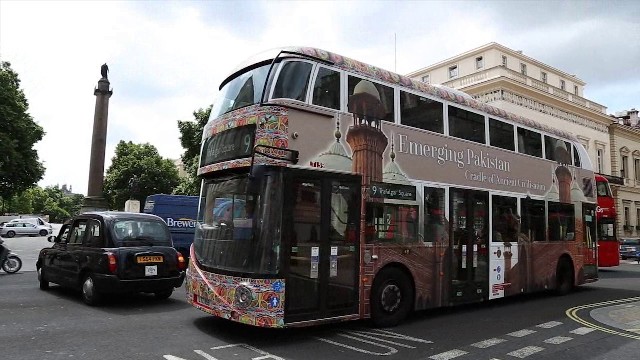 Pakistan has used London buses for its 70th anniversary branding campaign "Emerging Pakistan" [photo: Pakistan High Commission, London]
Pakistan has used London buses for its 70th anniversary branding campaign "Emerging Pakistan" [photo: Pakistan High Commission, London]
The 70th anniversary celebration of Pakistan’s creation as a nation state was exuberant and colourful. News footage showed happy people coming out onto the streets to rejoice; hundreds of green and white Pakistani flags with the distinctive crescent moon, adorned buildings, buses and cars. Having attained its three-score years and ten, Pakistan has indeed come of age. Many of those born after independence are past middle age and those who experienced the trauma of the partition of the subcontinent are a diminishing number.
Yet beneath the surface exhilaration, the country remains riven with political, economic, social and religious divisions. Created in 1947 to be a homeland for Muslims of the subcontinent, the cherished national objective of achieving ‘faith, unity, discipline’ remains a mirage. Even as its citizens were preparing to celebrate independence, Prime Minister Nawaz Sharif was being forced to resign on account of the all too familiar charge of corruption. Yet again a sitting Prime Minister had been unable to complete his term of office and stand for re-election.
If one talks to the average Pakistani, there will be a variety of reasons to explain why in 70 years Pakistan has still not achieved its potential. These range from it being the fault of its neighbour India, firstly for not allowing Pakistan to include the whole of the state of Jammu and Kashmir within its borders in 1947 and then for assisting in the break-up of the two constituent parts of the country, East and West Pakistan, in 1971. Then there are the actions of the ‘great Satan’, the United States of America, whose leaders, many Pakistanis claim, have treated their country like a pliant tool, to be picked up when necessary (such as during the war against the Soviet Union in Afghanistan 1979–89 or during the ‘war on terror’ following 11 September 2001) before being cast aside when no longer useful. President Trump’s latest ‘fight to win’ strategy in Afghanistan, calling on India to play a more active role while hardening his stance against Pakistan, is the latest example. Others will look closer to home, blaming the politicians not only for corruption but also poor administration despite all their promises and slogans. More specifically they may suggest that until Pakistan’s leaders institute a proper taxation system the socio-economic divide will remain, with the country perpetually reliant on foreign aid and contributions from its 7 million-strong diaspora.
Seasoned analysts will emphasise the demographic time bomb which Pakistan is sitting on. As the sixth most populous country in the world, with a population in excess of 190 million (and projected to reach over 210 million by 2020), the country is running out of sufficient water to sustain such enormous numbers, compared with the situation post-independence when the population of West Pakistan (as it then was) was around 35 million. Educational facilities, be they private or state, cannot keep pace with such a burgeoning population, nor can employment, let alone expenditure on health care. Inevitably this disparity increases the appeal of those promoting an alternative to western-style parliamentary democracy; the home-grown Tehrik-i-Taliban Pakistan (TTP), formed in 2007, has created another dangerous fissure in the country’s body politic.
For 70 years the only institution which has acted as a stabilising force, protecting its citizens from within and without, is the military, with over one million men either on active duty or in reserve. Expenditure on defence, constituting a significant proportion of the national budget, is testimony to the military’s overweening requirements. But a country run as a garrison state cannot develop beyond the military’s mindset, its vision permanently obscured by the country’s fractious relationship with India. Since 1947 a constant refrain has been that the military’s dominant position in the country is justified because of the need to be ready to ‘fight India’. This has allowed the army, both overtly (during three military interventions during 1958–69, 1977–88 and 1999–2008) and covertly to run the country. While soldiers die in Waziristan fighting the TTP, elements of the Pakistani military have assisted the insurgency in the valley of Kashmir, less for the benefit of the inhabitants of this disputed territory, and more to undermine India. The ill-fated excursion into the mountains above Kargil in 1999 was one such attempt, their activities sustained by the belief that Indian agents have been undertaking similar ‘dirty tricks’ to create disaffection in Balochistan.
Yet despite Pakistan’s negative image of a ‘failed’ or ‘failing’ state, it remains a magnificent country with huge agricultural, industrial and mineral assets, spanning over 340,000 square miles in a strategically important geographic location.
Victoria Schofield is an historian and commentator on international affairs and the Chair of the Round Table Journal Editorial Board.



